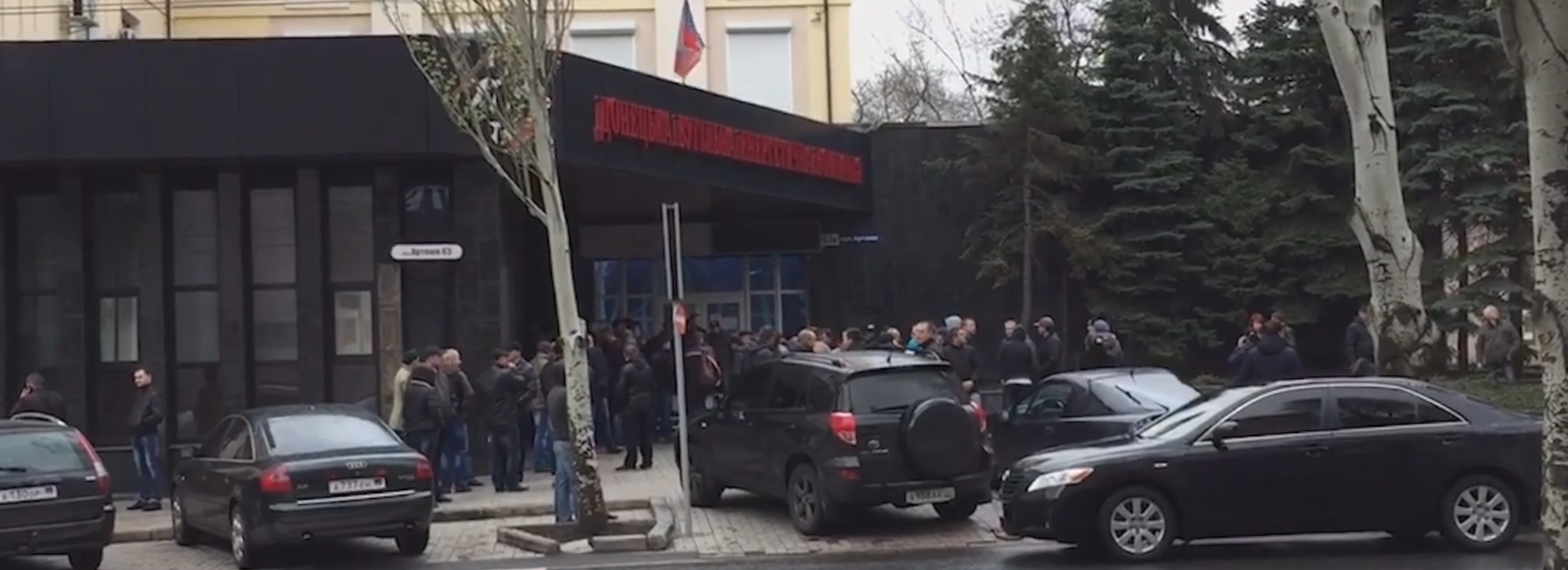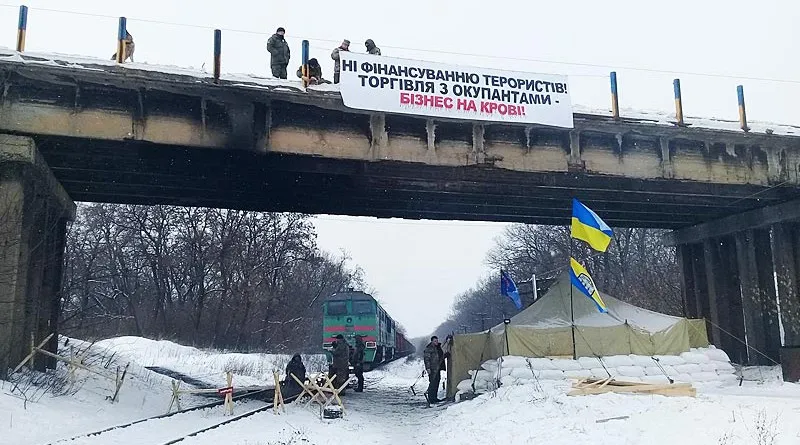Rare Labor-Related Protest in Occupied Donetsk
Why did the protest happen, and what’s next?
Rare Labor-Related Protest in Occupied Donetsk
Share this story

BANNER: Screenshot from Donbas Public TV reportage on Donetsk miners’ protest (source)
A rare labor protest took place in occupied Donetsk city on April 19. Approximately 60 miners rallied in Lenin Square then moved to the so-called Donetsk People’s Republic’s (DNR) Ministry of Energy and Coal headquarters. According to reports from Novosti Donbas, protesters were allowed into the building, presumably to discuss their concerns.
While there have been a number of rallies in separatist-occupied territories in the last three years, labor-related protests have been fairly rare. What led to these protests, and is there future unrest on the horizon?
Ukrainian coal blockade
An ongoing Ukrainian activist-led trade blockade has forced Ukrainian-operated coal mines and metallurgical facilities located in non-government controlled areas to cease operations and lay off their employees.
The blockade is one move in a circular dance of recrimination. Ukraine relies on the east of the country for its coal; the east relies on the rest of the country to buy it. Now that Russia and the separatists it backs have taken control of the mines, and activists in government-held Ukraine have blockaded coal supplies, Ukraine is running short of coal, and the mines are running short of customers.
While in Yenakiieve in mid-February, the OSCE SMM to Ukraine spoke with a DTEK Energy plant manager, who stated that up to 15,000 jobs would be endangered if the factory were to close. Since the blockade, DTEK Energy, founded by Rinat Akhmetov, Ukraine’s richest man according to Forbes, has ceased all operations in occupied territory. One of the companies operating affected facilities is Ukrainian steel producer Metinvest, which previously stated that some 20,000 employees would be dismissed if they lost control of their facilities.
In particular, this blockade has led to a sharp decrease in anthracite coal supplies. In March, Ukraine’s Cabinet of Ministers extended a February 15 state of emergency as decreasing stores of anthracite coal continued to threaten Ukraine’s power grid. Ukraine’s energy infrastructure is dependent on anthracite coal, a rare variety that is only produced in Ukraine, Russia, and South Africa. Anthracitic coal-powered thermal power plants contribute approximately 40 per cent of the country’s coal-based energy consumption and more than 25 per cent of the total energy supply. Anthracite coal is used for metallurgy facilities, electricity, and heat; as stores dwindle, controlled power-outages could increase in frequency with subsequent cascading effects on the economy and quality of life.
The Ukrainian activist-led trade blockade that triggered this shortage began on December 26, 2016. The activists, most of whom are Ukrainian Armed Forces (UAF) veterans of the Donbas and Aidar Battalions, announced the blockade in response to the illegal detention of former comrades by the “LNR” and “DNR.” At its height, the blockade grew to include railway crossings in Hirske and Shcherbynivka and road junctions in Karbonit, Zolote, and Buhas, but decreased in size following the seizure of facilities on March 1.

30.01.2017 Блокада торговли с оккупированными территориями https://t.co/eZR4qDS0NM pic.twitter.com/RZo0HxDghO
— Roman (@roman_primorye) January 30, 2017
Political Responses to the Blockade
The Ukrainian government officially condemns the blockade; President Petro Poroshenko stated that the blockade is damaging Ukraine, blocking “our struggle for restoration of territorial integrity.”
Prime Minister Volodymyr Groysman emphasized the importance for Ukraine to continue preventing the illegal trafficking of resources and goods from occupied Donbas but argued that it “is necessary to distinguish the fight against smuggling and the fight against the Ukrainian people.”
Interior Minister Arsen Avakov called for the military to lift the blockade and Minister of Temporarily Occupied Territories and IDPs Vadym Chernysh condemned it as damaging to ongoing political and diplomatic processes.
Former Georgian President and Governor of Odessa Oblast Mikheil Saakashvili participated in the blockade on February 13, a largely political move at which he declared Russian President Vladimir Putin and Akhmetov responsible. He dramatically proclaimed that people are paying for coal with “the lives of their children,” without actually taking any action.
The heads of the “DNR,” Alexander Zakharchenko, and “LNR,” Igor Plotnitsky, released a joint statement on February 27 calling the blockade a move organized by Ukraine that “goes directly against both the spirit and the letter of the Minsk Agreements and generally characterizes this Ukrainian leadership as one unable to take care of its citizens.” Separatist leaders threatened to confiscate the coal facilities and cut Ukraine off from its sources of anthracite coal — a promise they have since followed up on. Below, a map shows some of the most significant industrial facilities, including factories and mines, that are now under separatist control after being confiscated by DNR authorities.
However, without demand from Ukraine’s energy sector, separatist-controlled coal mines and metallurgical facilities will not have the demand needed to operate at their previous capacities. While announcements have been made to export coal to Russia and Crimea, sizable exports that would compare to previous exports to Ukraine are unlikely given Russia’s own anthracite coal mines and metallurgical facilities. This economic environment will lead to continued unemployment and growing discontent.
Conclusion
While much has been made of the significant linguistic and ethnic factors influencing the Russian-fueled conflict in eastern Ukraine, economic indicators may be just as important. Yuri Zhukov, an associate professor of political science at the University of Michigan, has argued that “local economic factors are stronger predictors of rebel violence and territorial control than Russian ethnicity or language,” making labor-related unrest in eastern Ukraine an essential issue to monitor, just like movements of Russian military equipment or personnel into the Donbas. One of the thirteen measures of the second Minsk agreement is the “full restoration of social and economic connections” between government-controlled and occupied territories — something directly contradicted by the ongoing coal blockades. Furthermore, ordinary workers and their families in occupied territories are amongst the hardest hit by the coal blockade, making future reconciliation between those still live and work in the occupied Donbas and the Ukrainian government more difficult.
While Russia-backed separatist forces in eastern Ukraine have a fairly firm political and military grip on the region, the area has been decimated economically, with little hope on the horizon. With the heavy industry and mining activities in the region so dependent on the trade of coal, more significant unrest may become an issue as the blockade continues.

